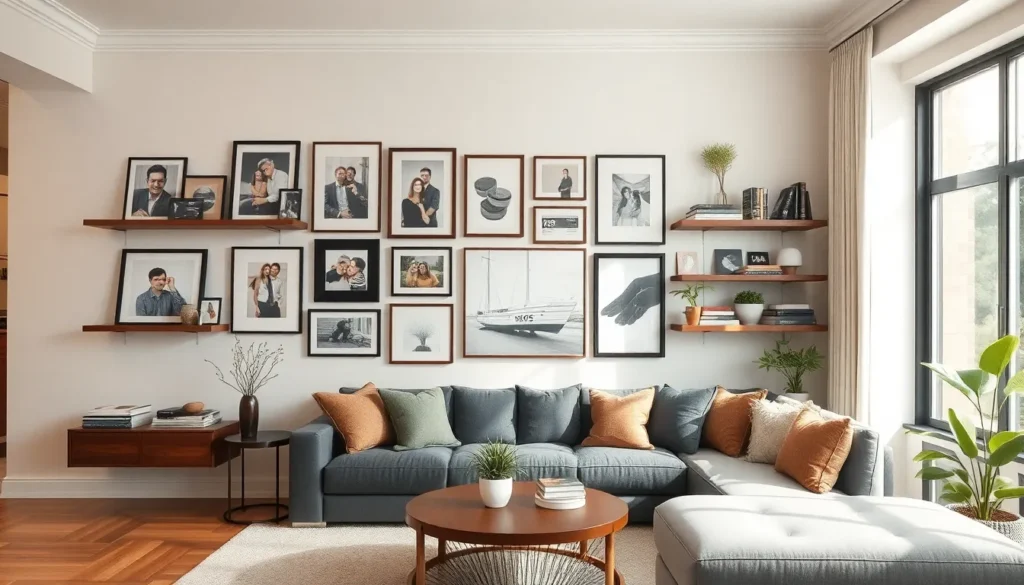We’ve all stared at those blank living room walls wondering how to transform them from boring barriers into stunning focal points. Your walls are prime real estate – they’re the largest canvas in your home and the perfect opportunity to showcase your personality while creating visual interest.
Whether you’re working with a tight budget or ready to splurge on statement pieces, there’s no shortage of creative ways to breathe life into your living space. From gallery walls that tell your story to bold wallpaper that makes guests stop and stare, we’ll explore dozens of wall decorating ideas that’ll make your living room the envy of every visitor.
The best part? You don’t need to be an interior designer to pull off these looks. We’ll share practical tips and budget-friendly answers that’ll help you create a living room that’s both beautiful and uniquely yours. Let’s turn those empty walls into your home’s most impressive feature.
Create a Gallery Wall With Personal Photos and Artwork
Gallery walls transform empty living room spaces into personalized showcases that tell your unique story. We’ll explore how strategic combinations of photos and artwork create stunning focal points that reflect your personality.
Mix Different Frame Sizes and Styles
Varying frame dimensions creates visual depth and prevents your gallery wall from looking monotonous. We recommend starting with three core sizes: large statement pieces (16×20 inches), medium focal points (11×14 inches), and small accent frames (8×10 inches). This size variation guides the eye naturally across your display.
Combining different frame styles adds character and prevents your wall from appearing too uniform. Mix sleek black frames with ornate gold ones, or pair rustic wood frames with modern white borders. We suggest limiting yourself to three frame styles maximum to maintain visual cohesion while adding interest.
Positioning larger frames as anchor points helps organize your entire gallery layout. Place your biggest pieces first, then fill in around them with medium and small frames. This approach creates natural balance and prevents your wall from feeling cluttered or overwhelming.
Incorporate Family Photos With Art Prints
Blending personal photographs with artistic prints creates a gallery wall that’s both meaningful and visually striking. We recommend using a 60/40 ratio, with 60% personal photos and 40% art prints for optimal balance. This combination ensures your wall feels personal without sacrificing artistic appeal.
Selecting art prints that complement your family photos enhances the overall aesthetic cohesion. Choose prints with similar color palettes or themes that connect to your personal style. Abstract pieces work particularly well alongside family portraits, creating sophisticated contrast without competing for attention.
Treating family photos as art pieces elevates their impact within your gallery arrangement. We suggest printing your best family moments in high quality and framing them with the same care you’d give expensive artwork. Black and white family photos often integrate seamlessly with colorful art prints.
Use a Cohesive Color Scheme
Establishing a unified color palette ties your entire gallery wall together visually. We recommend choosing three to four main colors that appear throughout your living room decor. These colors should repeat across both your frames and the artwork itself for maximum impact.
Incorporating neutral tones as your base allows colorful accent pieces to shine without overwhelming the space. Use whites, blacks, and grays as your foundation, then add pops of color through select art pieces or photo mats. This approach creates sophisticated depth while maintaining visual harmony.
Considering your existing living room colors ensures your gallery wall complements rather than clashes with your decor. Pull accent colors from your furniture, pillows, or rugs to create seamless integration. We find that gallery walls work best when they enhance your room’s existing color story rather than introducing entirely new palettes.
Install Floating Shelves for Functional Display

Floating shelves offer an elegant solution for wall decoration while maximizing floor space in your living room. We recommend this versatile option because it allows for easy restyling with new items, ensuring your space remains fresh and interesting.
Display Books and Decorative Objects
Books create an excellent foundation for sophisticated wall displays when paired with carefully chosen decorative objects. We suggest arranging hardcover books alongside ceramic vases, sculptural pieces, or vintage finds to achieve visual balance. This combination adds depth and layering to your room while showcasing your personal interests and style.
Consider alternating book spines with decorative items at varying heights to create rhythm across your floating shelves. Mix vertical and horizontal book arrangements to break up monotony and provide stable platforms for smaller decorative pieces. Incorporate items in different textures like wood, metal, or glass to enhance the overall visual appeal.
Create Layered Arrangements
Layered arrangements transform simple floating shelves into ever-changing focal points that draw the eye upward. We recommend combining framed pictures, small mirrors, and three dimensional objects to create depth and visual interest on your wall. Position larger items toward the back and smaller pieces in front to establish proper layering.
Vary the heights of your decorative elements by using books as risers or incorporating objects of different sizes. Overlap frames slightly or lean artwork against the wall behind other objects to create that coveted collected over time appearance. This technique adds sophistication and prevents your shelves from looking too rigid or formal.
Add Small Plants and Greenery
Small plants bring natural elements into your living room while improving the overall aesthetic of your floating shelf displays. We suggest incorporating trailing plants like pothos or string of pearls that can cascade over shelf edges for added movement and texture. Succulents in attractive planters work particularly well for low maintenance greenery that adds color variation.
Position plants at different levels across your shelves to create a refreshing atmosphere throughout your wall display. Choose planters that complement your existing decor while considering the natural light available in your living room. Fresh greenery creates a living element that changes and grows, keeping your wall decoration ever-changing and evolving.
Hang Statement Mirrors to Expand Your Space
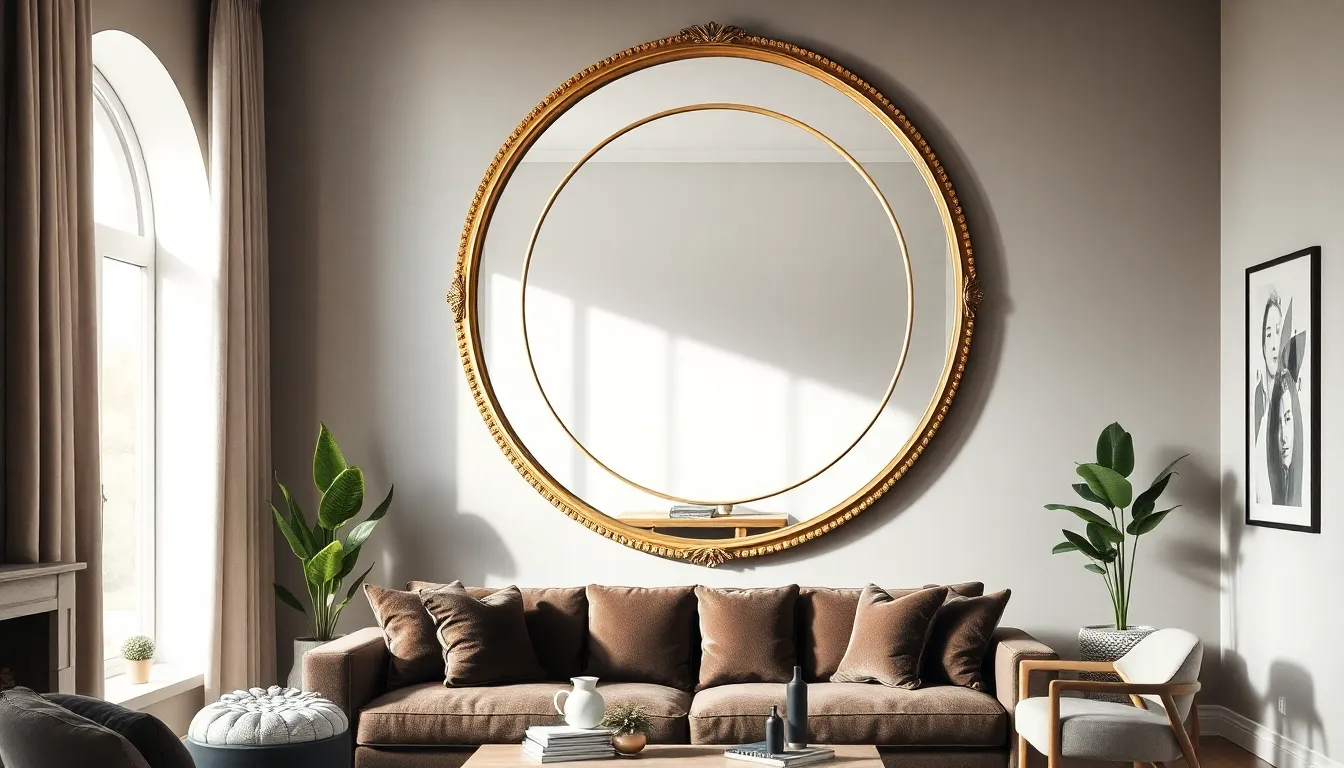
Statement mirrors transform cramped living rooms into spacious sanctuaries by reflecting light and creating visual depth. We’ll show you how these functional focal points can dramatically enhance your space while serving as stunning wall art.
Choose Oversized Mirrors for Drama
Oversized mirrors amplify drama and grandeur in any living area while creating the illusion of expanded space. We recommend positioning these large mirrors opposite windows to maximize natural light reflection and visually double your room’s size. Floor-to-ceiling mirrors work exceptionally well in narrow spaces, making them appear wider and more open.
Large statement mirrors function as artwork themselves, eliminating the need for additional wall decorations in minimalist rooms. We suggest choosing mirrors that are at least 36 inches in diameter or width to achieve maximum visual impact. Leaning an oversized mirror against the wall creates a casual, modern look that’s perfect for contemporary living rooms.
Group Multiple Mirrors Together
Gallery walls featuring multiple mirrors create captivating visual interest while maintaining the space-expanding benefits of reflective surfaces. We recommend mixing mirrors of various sizes and shapes to establish a ever-changing arrangement that draws the eye across the entire wall. Start with three to five mirrors as your foundation, then add more pieces as needed to fill the space.
Arranging mirrors in odd numbers creates more visually appealing compositions than even groupings. We suggest placing the largest mirror as your anchor point, then surrounding it with smaller pieces to create balance. Maintain consistent spacing of 2-3 inches between frames to achieve a cohesive gallery wall appearance.
Select Unique Shapes and Frames
Geometric mirrors with unusual shapes add character and personality to your living room walls beyond traditional rectangular designs. We love circular mirrors for their ability to soften angular furniture and architectural elements, while arched mirrors introduce elegant curves that complement both modern and vintage decor styles.
Decorative frames elevate simple mirrors into statement pieces that reflect your personal style. We recommend brass-framed mirrors for warm, luxurious appeal, or black metal frames for contemporary industrial looks. Sunburst mirrors create dramatic focal points, while rope or rattan frames add natural texture that works beautifully in bohemian or coastal-themed spaces.
Add Texture With Wall Decals and Wallpaper
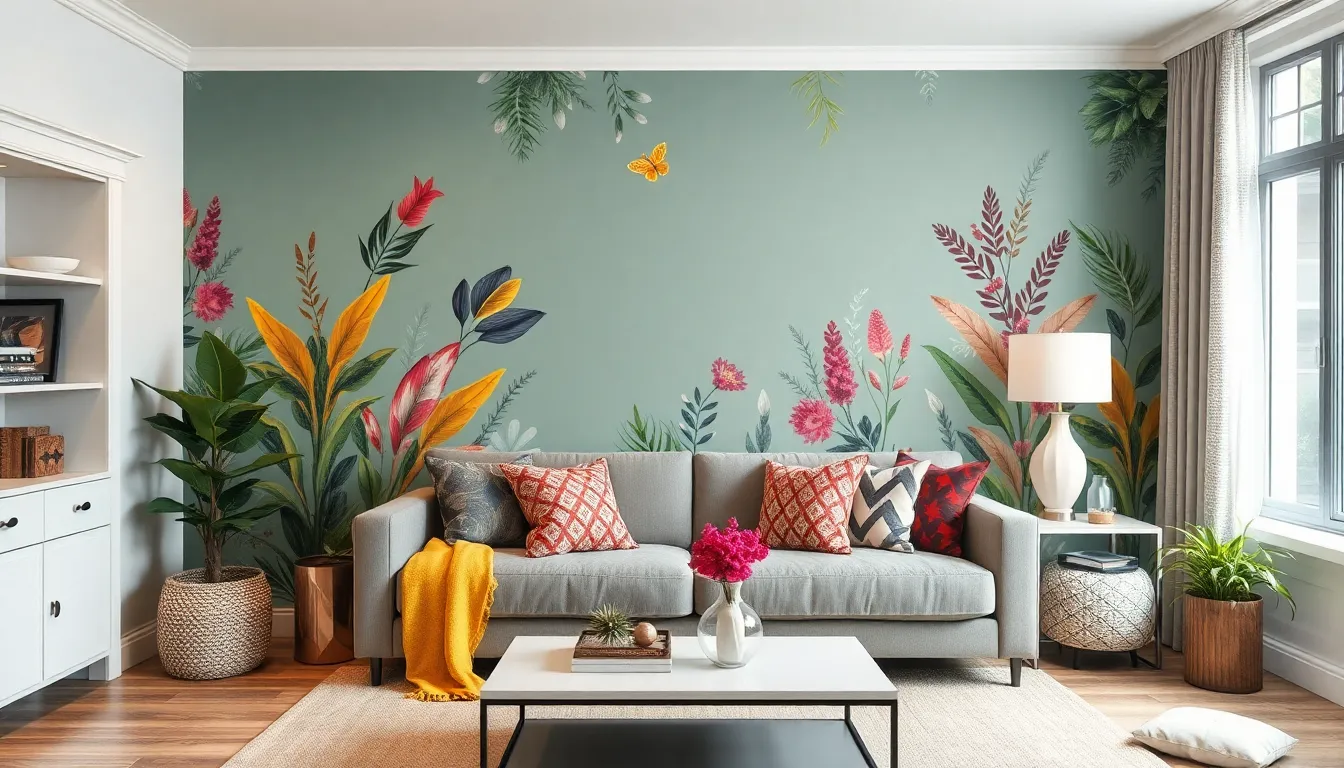
Adding texture transforms flat walls into ever-changing focal points that enhance your living room’s visual appeal. These versatile decorating answers offer endless possibilities for creating stunning wall displays.
Use Removable Wall Decals for Renters
Removable wall decals provide the perfect solution for renters who want to personalize their space without risking security deposits. These temporary designs offer incredible versatility, allowing you to experiment with geometric patterns, botanical motifs, or abstract shapes that complement your existing decor.
Applying decals requires minimal effort while delivering maximum impact on your living room walls. You can create custom arrangements by combining multiple decal designs or using single statement pieces as focal points. The removable adhesive technology ensures clean removal without damaging paint or leaving residue behind.
We recommend choosing decals that coordinate with your color scheme while adding visual interest through contrasting tones or complementary patterns. Large scale decals work beautifully above sofas or entertainment centers, while smaller designs create charming accents around doorways or windows.
Create an Accent Wall With Peel-and-Stick Wallpaper
Peel-and-stick wallpaper transforms ordinary walls into stunning accent features that anchor your living room design. This modern wallpaper solution eliminates the mess and commitment of traditional wallpaper while offering professional looking results.
Selecting the right wall for your accent feature typically means choosing the wall behind your sofa, fireplace, or entertainment center. Bold patterns like geometric designs or botanical prints create dramatic focal points, while subtle textures add sophistication without overwhelming the space.
Installation becomes straightforward with peel-and-stick technology, requiring only basic measuring and cutting skills. We suggest starting from the center of your chosen wall and working outward to ensure balanced pattern placement. The repositionable adhesive allows for adjustments during installation, making it forgiving for first time users.
Mix Patterns and Textures Strategically
Strategic pattern mixing creates sophisticated wall displays that showcase your design expertise while maintaining visual harmony. Combining different textures like smooth metallic decals with textured wallpaper adds depth and dimension to your living room walls.
Balancing smooth and rough textures prevents overwhelming the space while creating captivating visual contrast. For example, pairing sleek geometric decals with grasscloth textured wallpaper creates an elegant interplay between modern and natural elements.
We recommend limiting your pattern palette to two or three designs that share common colors or complementary themes. Stripes paired with florals work beautifully when they share similar color intensities, while geometric shapes complement organic patterns when balanced properly across the wall space.
Display Large Canvas Prints or Paintings
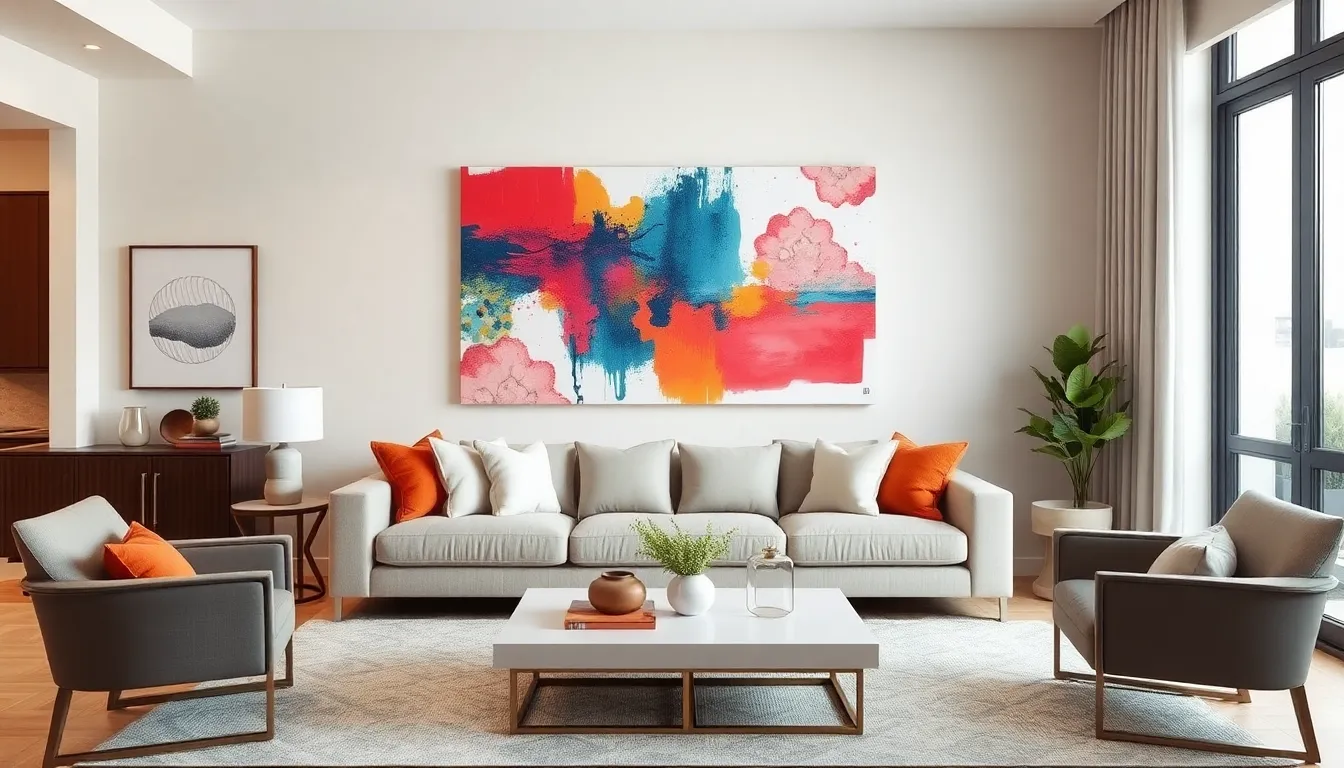
Large canvas prints and paintings instantly transform blank walls into stunning focal points that anchor your entire living room design. These substantial art pieces create visual weight and establish the room’s overall aesthetic direction.
Choose Artwork That Reflects Your Style
Selecting artwork that aligns with your personal taste ensures your living room feels authentic and inviting. Your chosen pieces should complement your existing decor while expressing your unique personality and preferences.
Modern homeowners often gravitate toward contemporary abstract pieces that feature bold colors and geometric shapes. These works create ever-changing energy and pair beautifully with minimalist furniture and clean architectural lines.
Traditional enthusiasts typically prefer classic industry paintings or realistic portraits that evoke timeless elegance. Oil paintings with rich textures and warm color palettes enhance rooms with vintage furniture and ornate details.
Eclectic collectors might mix different artistic styles to create an interesting contrast that sparks conversation. Combining modern photography with vintage illustrations or abstract paintings with realistic sketches adds depth and personality to your space.
Consider Abstract or Industry Pieces
Abstract art adds unique visual interest through bold colors, ever-changing shapes, and expressive brushstrokes that captivate viewers. These pieces work particularly well in contemporary spaces where they can serve as conversation starters and mood setters.
Industry paintings bring natural beauty indoors and create a sense of calm that makes living rooms feel more peaceful. Mountain scenes, ocean views, or forest landscapes help establish a serene atmosphere that promotes relaxation and tranquility.
Abstract pieces offer versatility in color coordination since they often feature multiple hues that can tie together various room elements. You can pull accent colors from the artwork to incorporate into throw pillows, rugs, or decorative accessories throughout the space.
Industry artwork provides an escape from urban environments and connects interior spaces with the natural industry. Large nature scenes can make rooms feel more spacious while creating a restful backdrop for daily activities.
Scale Artwork Appropriately to Wall Size
Properly scaled artwork ensures visual balance and prevents pieces from overwhelming or disappearing within your space. Large walls require substantial art pieces that can hold their own against expansive surfaces.
Oversized canvases work best on walls that measure at least 8 feet wide and have minimal competing elements. These statement pieces need breathing room to make their full impact and should occupy roughly two thirds of the available wall space.
Small artwork gets lost on large walls and fails to create the desired focal point effect. Instead of using tiny pieces, consider grouping multiple medium sized canvases together to achieve proper visual weight and presence.
Wall proportions should guide your size selection process to ensure the artwork enhances rather than disrupts the room’s harmony. Measure your wall space carefully and choose pieces that feel substantial without crowding adjacent furniture or architectural features.
Install Built-In or Faux Built-In Storage
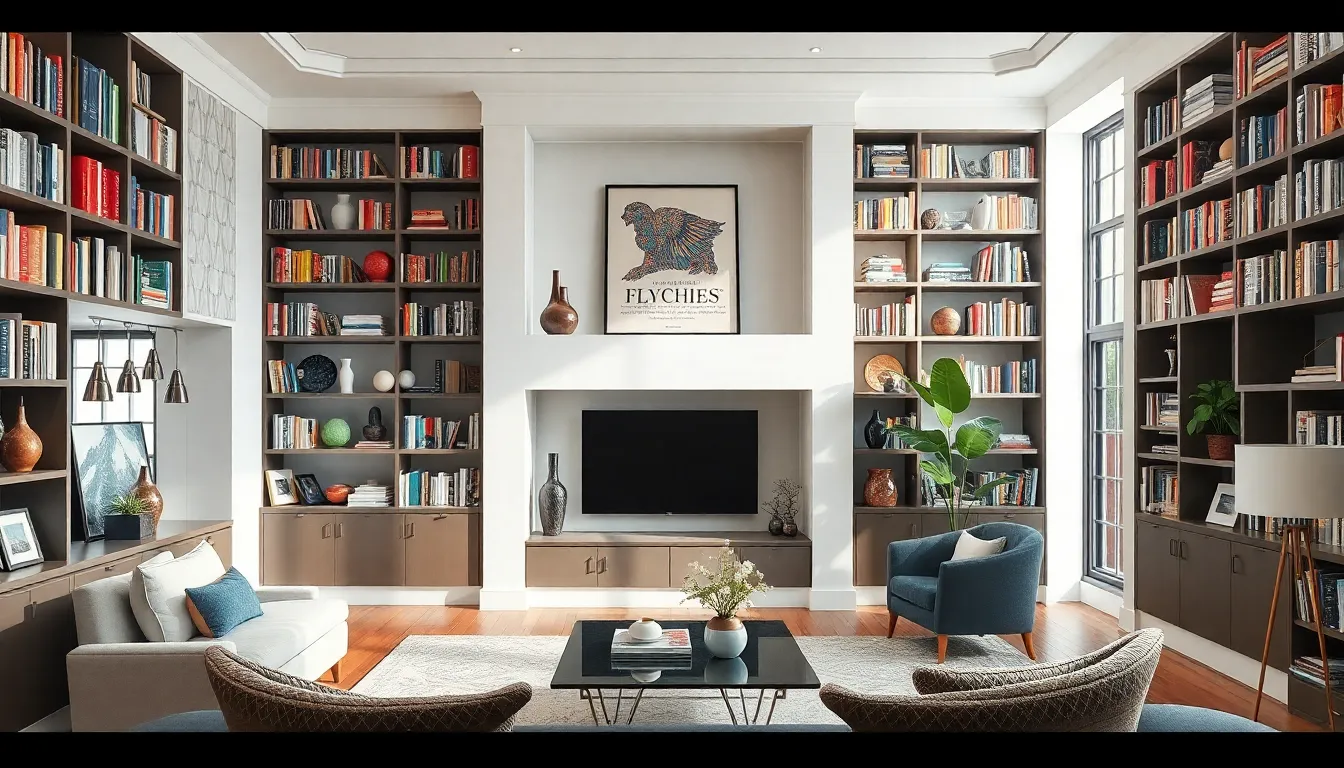
Built-in or faux built-in storage transforms your living room walls into functional masterpieces that seamlessly blend with your existing architecture. These custom answers maximize space while maintaining the clean, organized aesthetic that makes modern homes feel both sophisticated and livable.
Add Floor-to-Ceiling Bookshelves
Floor-to-ceiling bookshelves create dramatic vertical interest that draws the eye upward and makes your living room feel more spacious than it actually is. We recommend installing these towering storage answers along entire walls to maximize both storage capacity and visual impact in your space.
Books aren’t the only items that belong on these impressive shelves. Display decorative objects like ceramic vases, picture frames, and small sculptures between your favorite novels to create sophisticated styling that reflects your personality. Plants add natural elements that soften the linear structure of floor-to-ceiling shelving units.
Mixing horizontal and vertical book arrangements creates visual rhythm throughout your shelving display. Stack some books horizontally to create platforms for decorative accessories while keeping others upright in traditional fashion. This combination adds depth and prevents your shelves from looking monotonous or overly uniform.
Create Custom Display Niches
Custom display niches provide unique recessed areas within your walls that showcase important decorative objects and artwork with museum-quality presentation. These built-in alcoves blend seamlessly into your wall structure, creating sophisticated focal points that appear intentionally designed rather than added as afterthoughts.
Artwork becomes the star of the show when properly displayed in custom niches that frame pieces perfectly. We suggest sizing these recessed areas slightly larger than your chosen items to create breathing room that enhances their visual impact. Lighting installed within each niche illuminates your displays and creates dramatic shadows that add depth.
Decorative objects gain prominence when positioned in thoughtfully designed display niches throughout your living room walls. Consider grouping items by color, texture, or theme within individual niches to create cohesive collections that tell visual stories about your interests and travels.
Incorporate Hidden Storage Answers
Hidden storage answers keep clutter completely out of sight while maintaining the clean, streamlined appearance that makes living rooms feel calm and organized. Secret compartments built into wall panels provide discrete storage for items like remote controls, charging cables, and seasonal decorations that you need but don’t want displayed.
Sliding panels disguised as decorative wall elements reveal hidden storage areas when needed while maintaining your room’s aesthetic integrity. We recommend incorporating these clever answers behind artwork or within faux built-in entertainment centers where they won’t disrupt your overall design scheme.
Push-to-open mechanisms eliminate the need for visible handles or hardware that might compromise your wall’s sleek appearance. These touch-activated storage areas blend invisibly into your living room walls until you need to access the items stored within them.
Use Wall-Mounted Planters for Living Decor
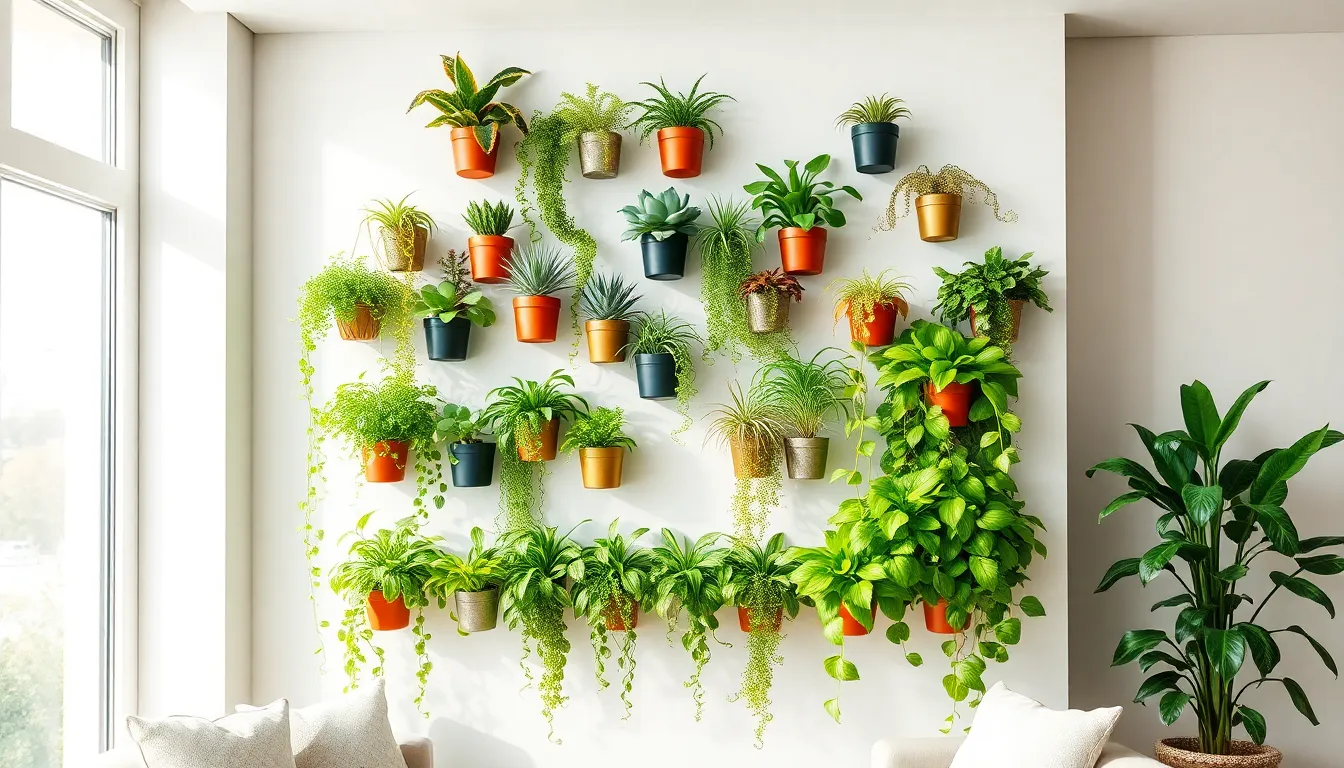
Wall-mounted planters bring natural beauty to your living room while creating an eco-friendly focal point that purifies the air. This living decor solution maximizes floor space while adding vibrant greenery to otherwise plain walls.
Create a Vertical Garden Wall
Vertical garden walls transform empty wall space into stunning natural artwork that becomes the room’s main attraction. We recommend starting with a grid pattern using identical wall-mounted planters to create visual cohesion and structure. Staggered arrangements work particularly well when you want to add organic movement to your vertical display.
Strategic placement makes your vertical garden wall more impactful and functional. Position your garden wall near natural light sources to ensure healthy plant growth while creating beautiful shadow patterns throughout the day. Corner installations maximize unused space and create dramatic floor-to-ceiling displays that draw the eye upward.
Modular planter systems offer flexibility for expanding your vertical garden over time. These systems allow you to start small with just a few planters and gradually build your living wall as your confidence and plant collection grows. Professional-grade mounting hardware ensures your vertical garden remains secure even as plants mature and gain weight.
Choose Low-Maintenance Indoor Plants
Succulents provide the perfect starting point for wall-mounted planters because they require minimal watering and thrive in various light conditions. Varieties like echeveria, jade plants, and string of pearls create interesting textures and shapes that add visual appeal to your living wall. These hardy plants forgive occasional neglect while maintaining their attractive appearance year-round.
Air plants offer another excellent low-maintenance option that doesn’t require soil, making them ideal for unique planter designs. Tillandsia varieties attach directly to mounting surfaces or decorative holders, creating floating green elements that seem to defy gravity. Misting them once or twice weekly provides all the moisture they need to flourish.
Pothos and snake plants work exceptionally well for larger wall-mounted planters where you want substantial greenery with minimal effort. These plants adapt to various lighting conditions and only need watering when the soil feels dry to the touch. Their trailing or upright growth patterns create different visual effects depending on your design goals.
Mix Different Planter Styles and Materials
Metal planters bring industrial elegance to your wall display while offering durability and weather resistance for long-term use. Copper and brass planters develop attractive patinas over time, adding character and warmth to your living room walls. Powder-coated steel options come in various colors that can complement or contrast with your existing decor scheme.
Wood planters introduce natural warmth and organic textures that pair beautifully with greenery and other natural materials. Cedar and teak varieties resist moisture damage while developing rich patinas that enhance their visual appeal over time. Reclaimed wood planters add rustic charm and environmental consciousness to your wall decor approach.
Ceramic planters offer endless design possibilities with glazed finishes, hand-painted details, and sculptural shapes that double as artwork. Mixing matte and glossy ceramic finishes creates visual interest while maintaining a cohesive color palette throughout your planter collection. Geometric ceramic shapes work particularly well in modern living rooms where clean lines and bold forms are preferred.
Incorporate Vintage or Antique Finds
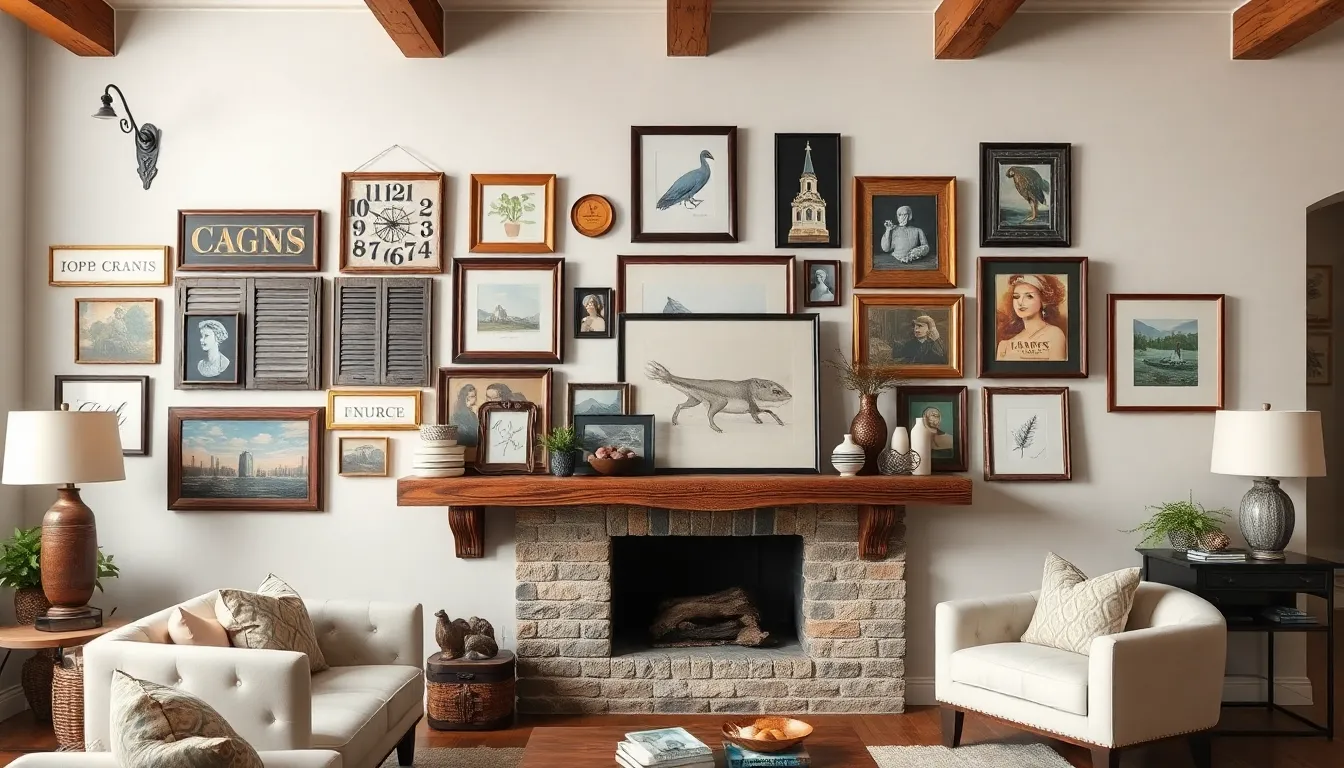
Vintage and antique treasures transform ordinary living room walls into storytelling displays that blend history with personal style. We’ll guide you through sourcing and styling these timeless pieces to create walls that captivate and inspire.
Hunt for Unique Pieces at Thrift Stores
Start your treasure hunt at thrift stores, antique shops, flea markets, and vintage markets to discover one-of-a-kind pieces that can’t be found in regular retail stores. These environments offer architectural salvage like old corbels, mantels, and windows that make stunning statement wall art. We recommend visiting multiple locations regularly since inventory changes frequently, increasing your chances of finding exceptional pieces.
Focus on architectural elements that bring both history and character to your space. Old windows can be repurposed as unique photo frames, while vintage corbels create interesting sculptural elements on your walls. Antique wooden shutters work beautifully as rustic wall panels, and salvaged mantels can be mounted horizontally to create floating shelves with historical charm.
Display Vintage Signs and Advertisements
Incorporate vintage signs and advertisements to add personality and visual interest to your living room walls. Look for old metal or wooden signs, vintage posters, or printed advertisements that match your desired aesthetic, whether it’s industrial, rustic, or shabby chic. These pieces serve as natural conversation starters and focal points that reflect your unique taste.
Position these vintage advertisements strategically to create balanced compositions on your walls. Group smaller signs together to create impact, or use a single large vintage advertisement as a statement piece above your sofa. We suggest mixing different materials like weathered metal signs with vintage wooden advertisements to add textural variety and visual depth.
Mix Old and New Elements
Balance vintage finds with contemporary pieces to achieve a curated, layered look that feels both timeless and current. Pair antique mirrors or framed botanical prints with modern furnishings and contemporary art to create sophisticated visual contrast. This approach prevents your space from feeling like a museum while maintaining the charm of vintage elements.
Create gallery walls that combine antique frames, vintage botanical illustrations, and modern prints for ever-changing visual storytelling. We recommend using three to five vintage pieces mixed with two to three contemporary elements to maintain balance. Consider mounting collections of vintage plates alongside modern geometric art, or displaying aged mirrors next to sleek contemporary photography for compelling juxtapositions that enhance both old and new elements.
Add Architectural Elements Like Molding

Architectural details transform ordinary walls into sophisticated design statements that elevate the entire living room’s aesthetic appeal. We can incorporate various molding types to add depth, texture, and visual interest while creating a more polished, custom look.
Install Wainscoting or Chair Rails
Wainscoting creates an elegant foundation by covering the lower portion of walls with decorative panels that instantly upgrade any living space. We recommend installing traditional raised panel wainscoting for formal rooms or simple flat panel designs for contemporary spaces. Chair rails serve a dual purpose by protecting walls from furniture damage while adding horizontal visual interest that breaks up tall wall expanses.
Traditional wainscoting typically extends 32 to 36 inches from the floor, creating perfect proportions for most ceiling heights. We can paint the lower wainscoting section in darker tones while keeping upper walls lighter to add visual weight and grounding to the room. Chair rails work particularly well in dining areas that open to living spaces, creating cohesive design flow throughout connected rooms.
Create Decorative Wall Panels
Decorative wall panels offer unlimited customization opportunities using materials like wood, fabric, or composite materials to create unique focal points. We can design geometric patterns using thin wood strips to create modern panel designs that add dimension without overwhelming the space. Fabric covered panels provide acoustic benefits while introducing texture and color that complements existing furnishings.
Grid patterns work exceptionally well for contemporary spaces, while traditional raised panels suit classic decorating styles. We suggest painting panels in contrasting colors to make them pop against wall backgrounds, or matching wall colors for subtle texture addition. Lightweight foam panels covered in fabric offer budget friendly alternatives that deliver impressive visual impact.
Use Crown Molding for Elegance
Crown molding creates seamless transitions between walls and ceilings while adding sophisticated architectural detail that makes rooms feel more finished and expensive. We can choose simple profiles for modern spaces or elaborate designs with multiple layers for traditional rooms. Proper installation requires precise measuring and cutting, but the dramatic impact justifies the effort involved.
Different crown molding sizes work better for various ceiling heights, with 3 to 4 inch profiles suiting standard 8 foot ceilings perfectly. We recommend painting crown molding in ceiling colors to create height illusion or wall colors for bold contrast effects. Installing crown molding throughout connected living areas creates design continuity that unifies the entire space while adding perceived value to the home.
Design a Feature Wall With Bold Paint or Color

Creating a feature wall with bold paint transforms your living room into a space with dramatic visual impact. Bold colors serve as powerful focal points that anchor your room’s design while adding personality and depth to the overall aesthetic.
Choose an Accent Color That Complements Your Decor
Selecting the right accent color requires careful consideration of your existing furniture and decor elements. We recommend pulling colors from your current furnishings, artwork, or textiles to create a cohesive color story throughout the space. Rich jewel tones like emerald green or sapphire blue work beautifully in rooms with neutral furniture, while warm terracotta or deep burgundy complement wooden elements and brass accents.
Testing paint colors in different lighting conditions helps ensure your choice works throughout the day. Natural light reveals the truest color representation, while artificial lighting can shift how colors appear in the evening. We suggest painting large swatches directly on the wall and observing them for 24 hours before making your final decision.
Balancing bold choices with the room’s scale prevents overwhelming the space. Larger rooms can handle deeper, more saturated colors, while smaller spaces benefit from lighter versions of bold hues that still create impact without closing in the walls.
Use Color-Blocking Techniques
Color blocking divides your feature wall into geometric sections using contrasting or complementary colors. This technique creates visual interest through structured patterns that feel both modern and sophisticated. We recommend starting with two to three colors maximum to maintain a clean, intentional look.
Horizontal stripes elongate narrow rooms and make ceilings appear higher, while vertical divisions can make wide walls feel more proportioned. Using painter’s tape ensures crisp, professional lines between color sections. Remove the tape while the paint is still slightly wet to prevent peeling and achieve sharp edges.
Incorporating your room’s existing color palette into the blocking scheme ties the feature wall to the overall design. Consider using one neutral tone alongside your bold accent color, or experiment with different saturations of the same hue for a monochromatic approach.
Consider Ombre or Gradient Effects
Ombre effects create stunning visual movement by gradually transitioning from one color to another across the wall surface. This technique adds ever-changing energy while maintaining sophistication through its subtle color progression. We suggest starting with colors from the same family for the most harmonious results.
Blending techniques require working quickly while the paint remains workable. Use a large, dry brush or sponge to blend the edges where colors meet, creating smooth transitions between tones. Professional painters often use glazing techniques to extend working time and achieve seamless gradients.
Vertical gradients draw the eye upward and can make ceilings appear taller, while horizontal progressions create a sense of width in narrow spaces. Position the lightest color at eye level to create a natural focal point that feels comfortable and inviting in your living room.
Conclusion
We’ve explored countless ways to transform your living room walls from blank canvases into stunning focal points. Whether you’re drawn to gallery walls that tell your story or bold accent colors that make a statement these ideas offer something for every style and budget.
The key is choosing elements that reflect your personality while creating visual harmony throughout the space. Don’t be afraid to mix textures patterns and heights to add depth and interest to your walls.
Start with one or two ideas that excite you most then gradually build your wall decor over time. Remember that the best living rooms aren’t created overnight – they evolve as you discover what truly makes your space feel like home.
Frequently Asked Questions
What is the best way to create a gallery wall in my living room?
Start by mixing different frame sizes (large, medium, and small) while limiting frame styles to 2-3 for cohesion. Use larger frames as anchor points and maintain a 60/40 ratio of family photos to art prints. Choose 3-4 main colors that complement your existing decor, incorporating neutral tones with accent colors pulled from your furnishings.
How do I choose the right wall for an accent wall?
Select a wall that naturally draws attention, such as the one behind your sofa or the first wall visible when entering the room. Avoid walls with too many windows or doors, as they can interrupt the visual impact. Test your chosen paint color in different lighting conditions throughout the day before committing.
What are floating shelves and how should I style them?
Floating shelves are wall-mounted shelves without visible brackets that create clean, modern storage. Style them by mixing vertical and horizontal book arrangements, layering framed pictures with decorative objects, and varying heights for visual interest. Include small plants and mirrors to add depth and sophistication to your displays.
How can mirrors make my living room look bigger?
Mirrors reflect light and create visual depth, making spaces appear larger. Position oversized mirrors opposite windows to maximize natural light reflection. Group multiple mirrors in odd numbers for captivating visual interest while maintaining the space-expanding effect. Choose unique shapes and decorative frames to add personality.
Are removable wall decals good for renters?
Yes, removable wall decals are perfect for renters because they don’t damage walls and can be easily removed without leaving residue. They offer an affordable way to add personality and visual interest to blank walls. Peel-and-stick wallpaper is another renter-friendly option for creating accent walls.
How do I choose the right size artwork for my wall?
Scale artwork appropriately to your wall size for visual balance. Large walls need substantial pieces or groupings to avoid looking sparse, while smaller walls work better with medium-sized art. As a general rule, artwork should take up 60-75% of the wall space above furniture for proper proportion.
What’s the difference between built-in and faux built-in storage?
Built-in storage is permanently constructed into the wall, while faux built-ins use furniture and trim work to create the appearance of built-ins. Faux built-ins are more budget-friendly and removable, making them ideal for renters. Both options maximize space while maintaining a clean, custom aesthetic.
How do I create visual rhythm with books on shelves?
Mix horizontal and vertical book arrangements rather than placing all books vertically. Stack some books horizontally and place decorative objects on top, then intersperse with vertically placed books. This creates visual movement and prevents the monotonous appearance of uniform book placement.

